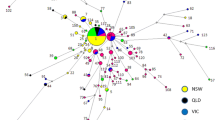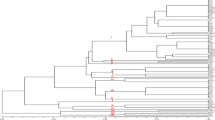Abstract
Chickpea is considered as one of the most important sources of proteins in many developing countries including Iraq. Didymella rabiei, causing ascochyta blight disease on chickpea, is a destructive pathogen on chickpea in the north of the Iraq (Kurdistan region). Detailed knowledge about the genetic diversity and pathogenicity of the pathogens is necessary to adopt appropriate disease control and management strategies. For the purposes of this study, a combination of phenotypic and genotypic characterizations including simple sequence repeat (SSR) fingerprinting, mating-types distribution and pathogenicity analyses were used to assess a total of 145 D. rabiei isolates collected from chickpea fields in the Sulaymaniyah provincial region of northern Iraq in 2020. Our results revealed a relatively high level of genetic diversity (H = 0.66) within populations, with low differentiation among populations. These findings together with mating types which were found in a 50:50 ratio, suggest the role of sexual reproduction in the fungus, primarily as primary inoculums of D. rabiei which are likely ascospores (sexual spores). On the contrary, the existence of gene exchanges through either the movement of infected seeds or plant debris is most probably the main mechanism in reduction of differentiation among populations. Hence, the use of certified chickpea seeds and removing plant debris are recommended for effective management of the disease.








Similar content being viewed by others
Data Availability
The authors confirm that the data supporting the results of this study are available within the articled and its supplementary material. Raw data that support the findings of this study are available from the corresponding author, upon reasonable request.
References
Ahmed, J. O., Mohammad, D. Y., Abdulla, A. R., & Meerza, C. H. N. (2018). Comparison of growth traits and yields components of five chickpeas genotypes (Cicer arietinum L.) at Bakrajo/ Sulaymaniyah conditions. Kurdistan Journal of Applied Research, 3(2), 1–5.
Ali, H., Alam, S. S., Attanayake, R. N., Rahman, M., & Chen, W. (2012). Population structure and mating type distribution of the chickpea blight pathogen Ascochyta rabiei from Pakistan and the United States. Journal of Plant Pathology, 1, 99–108.
Atik, O., Baum, M., El-Ahmed, A., Ahmed, S., Abang, M. M., Yabrak, M. M., Murad, S., Kabbabeh, S., & Hamwieh, A. (2011). Chickpea ascochyta blight: Disease status and pathogen mating type distribution in Syria. Journal of Phytopathology, 159(6), 443–449.
Bar, I., Sambasivam, P. T., Davidson, J., Farfan-Caceres, L. M., Lee, R. C., Hobson, K., Moore, K., & Ford, R. (2021). Current population structure and pathogenicity patterns of Ascochyta rabiei in Australia. Microbial Genome, 7(7), 000627.
Barve, M. P., Arie, T., Salimath, S. S., Muehlbauer, F. J. & Peever, T. L. (2003). Cloning and characterization of the mating type (MAT) locus from Ascochyta rabiei (teleomorph: Didymella rabiei) and a MAT phylogeny of legume-associated Ascochyta spp. Fungal Genetics and Biology, 39(2), 151–167.
Bayraktar, H., Dolar, F. S., & Tör, M. (2007). Determination of genetic diversity within Ascochyta rabiei (Pass.) Labr., the cause of ascochyta blight of chickpea in Turkey. Journal of Plant Pathology, 1, 341–347.
Bencheqroun, S. K., Ahmed, S., Imtiaz, M., Hamwieh, A., Udupa, S. M., Sahri, A., Aouzal, S., & Kehel, Z. (2022). Pathogen diversity and mating types of Didymella rabiei isolates collected from Morocco. Current Plant Biology, 29, 100231.
Burgess, T., Wingfield, M. J., & Wingfield, B. W. (2001). Simple sequence repeat markers distinguish among morphotypes of Sphaeropsis sapinea. Applied and Environmental Microbiology, 67(1), 354–362.
Chongo, G., Gossen, B. D., Buehwaldt, L., Adhikari, T., & Rimmer, S. R. (2004). Genetic diversity of Ascochyta rabiei in Canada. Plant Disease, 88(1), 4–10.
Della Rocca, G. I., Eyre, C. A., Danti, R., & Garbelotto, M. (2011). Sequence and simple-sequence repeat analyses of the fungal pathogen Seiridium cardinale indicate California is the most likely source of the Cypress canker epidemic for the Mediterranean region. Phytopathology, 101(12), 1408–1417.
Deokar, A., Sagi, M., Daba, K., & Tar’an, B. (2019). QTL sequencing strategy to map genomic regions associated with resistance to ascochyta blight in chickpea. Plant Biotechnology Journal, 17(1), 275–288.
Earl, D. A., & vonHoldt, B. M. (2011). STRUCTURE HARVESTER: A website and program for visualizing STRUCTURE output and implementing the Evanno method. Conservation Genetics Resources, 4, 359–361.
Farahani, S., Talebi, R., Maleki, M., Mehrabi, R., & Kanouni, H. (2019). Pathogenic diversity of Ascochyta rabiei isolates and identification of resistance sources in core collection of chickpea germplasm. Plant Pathology Journal, 35(4), 321.
Farahani, S., Talebi, R., Maleki, M., Mehrabi, R., & Kanouni, H. (2021). Mating type distribution, genetic diversity and population structure of Ascochyta rabiei, the cause of Ascochyta blight of chickpea in western Iran. Phytopathologia Mediterranea, 60(1), 3–11.
Farahani, S., Maleki, M., Ford, R., Mehrabi, R., Kanouni, H., Kema, G. H., Naji, A. M., & Talebi, R. (2022). Genome-wide association mapping for isolate-specific resistance to Ascochyta rabiei in chickpea (Cicer arietinum L.). Physiological and Molecular Plant Pathology, 121, 101883.
Gayacharan, Rani, U., Singh, S., Basandrai, A. K., Rathee, V. K., Tripathi, K., Singh, N., Dixit, G. P., Rana, J. C., Pandey, S., Kumar, A., & Singh, K. (2020). Identification of novel resistant sources for ascochyta blight (Ascochyta rabiei) in chickpea. Plos One, 15(10), e0240589
Geistlinger, J., Weising, K., Winter, P., & Kahl, G. (2000). Locus-specific microsatellite markers for the fungal chickpea pathogen Didymella rabiei (anarmoph) Ascochyta rabiei. Molecular Ecology, 9(11), 1939–1941.
Getaneh, G., Tefera, T., Lemessa, F., Ahmed, S., Fite, T., & Villinger, J. (2021). Genetic diversity and population structure of Didymella rabiei affecting chickpea in Ethiopia. Journal of Fungi, 30, 7(10), 820.
Karimi, K., Khodaei, S., Rota-Stabelli, O., Arzanlou, M., & Pertot, I. (2016). Identification and characterization of two new fungal pathogens of Polygonatum odoratum (Angular Solomon’s seal) in Italy. Journal of Phytopathology, 164(11–12), 1075–1084.
Kaye, C., Milazzo, J., Rozenfeld, S., Lebrun, M. H., & Tharreau, D. (2003). The development of simple sequence repeat markers for Magnaporthe grisea and their integration into an established genetic linkage map. Fungal Genetics Biology, 40(3), 207–214.
McDonald, B. A. (1997). The population genetics of fungi: Tools and techniques. Phytopathology, 87, 448–453.
McDonald, B. A., & Linde, C. (2002). The population genetics of plant pathogens and breeding strategies for durable resistance. Euphytica, 124(2), 163–180.
Möller, E. M., Bahnweg, G., Sandermann, H. & Geiger, H. H. (1992). A simple and efficient protocol for isolation of high molecular weight DNA from filamentous fungi, fruit bodies, and infected plant tissues. Nucleic Acids Research, 20(22), 6115–6116.
Nourollahi, K., Javannikkhah, M., Naghavi, M. R., Lichtenzveig, J., Okhovat, S. M., Oliver, R. P., & Ellwood, S. R. (2011). Genetic diversity and population structure of Ascochyta rabiei from the western Iranian Ilam and Kermanshah provinces using MAT and SSR markers. Mycological Progress, 10(1), 1–7.
Özer, G., Bayraktar, H. & Sara Dolar, F. (2012). Genetic diversity and mating-type distribution within populations of Ascochyta rabiei in Turkey. Indian Journal of Agricultural Sciences, 82(1), 3–7.
Ozkilinc, H., Frenkel, O., Abbo, S., Eshed, R., Sherman, A., Shtienberg, D., Ophir, R., & Can, C. (2010). A comparative study of Turkish and Israeli populations of Didymella rabiei, the ascochyta blight pathogen of chickpea. Plant Pathology, 59(3), 492–503.
Pande, S., Sharma, M., Gaur, P. M., Tripathi, S., Kaur, L., Basandrai, A., Khan, T., Gowda, C. L., & Siddique, K. H. (2011). Development of screening techniques and identification of new sources of resistance to Ascochyta blight disease of chickpea. Australasian Plant Pathology, 40(2), 149–156.
Peakall, R. O., & Smouse, P. E. (2006). GENALEX 6: genetic analysis in Excel. Population genetic software for teaching and research. Molecular Ecology Notes, 6(1), 288–95.
Perrier, X., Flori, A., & Bonnot, F. (2003). Data analysis methods. In: P. Hamon, M. Seguin, X. Perrier & J. C. Glaszmann (Eds.), Genetic diversity of cultivated tropical plants. (pp. 43–76). Science Publishers, Enfield, Montpellier.
Pritchard, J. K., Stephens, M., & Donnelly, P. (2000). Inference of population structure using multilocus genotype data. Genetics, 155, 945–959.
Rhaiem, A., Cherif, M., Dyer, P. S., & Peever, T. L. (2007). Distribution of mating types and genetic diversity of Ascochyta rabiei populations in Tunisia revealed by mating-type-specific PCR and random amplified polymorphic DNA markers. Journal of Phytopathology, 155(10), 596–605.
Rhaiem, A., Cherif, M., Peever, T. L., & Dyer, P. S. (2008). Population structure and mating system of Ascochyta rabiei in Tunisia: Evidence for the recent introduction of mating type 2. Plant Pathology, 57(3), 540–551.
Singh, R., Kumar, K., Purayannur, S., Chen, W., & Verma, P. K. (2022). Ascochyta rabiei: A threat to global chickpea production. Molecular Plant Pathology, 23, 1241–1261.
Taylor, P. W., & Ford, R. (2007). Diagnostics, genetic diversity and pathogenic variation of ascochyta blight of cool season food and feed legumes. In: B. Tivoli, A. Baranger, J. M. Fred, & B. M. Cooke (Eds.), Ascochyta blights of grain legumes, (pp. 127–133). Dordrecht.
Tóth, G., Gáspári, Z., & Jurka, J. (2000). Microsatellites in different eukaryotic genomes: Survey and analysis. Genome Research, 10(7), 967–981.
Varshney, R., Pande, S., Kannan, S., Mahendar, T., Sharma, M., Gaur, P., & Hoisington, D. (2009). Assessment and comparison of AFLP and SSR based molecular genetic diversity in Indian isolates of Ascochyta rabiei, a causal agent of Ascochyta blight in chickpea (Cicer arietinum L.). Mycological Progress, 8(2), 87–97.
Yeh, F. C., & Boyle, T. J. B. (1997). Population genetic analysis of co-dominant and dominant markers and quantitative traits. Belgian Journal of Botany, 129, 157.
Acknowledgements
The authors wish to thank Research Deputy of Islamic Azad University, Science and Research branch, Tehran for financial support of the project.
Author information
Authors and Affiliations
Corresponding author
Ethics declarations
Conflict of interest
The authors have no competing interests to declare that are relevant to the content of this article.
Supplementary Information
Below is the link to the electronic supplementary material.
Rights and permissions
Springer Nature or its licensor (e.g. a society or other partner) holds exclusive rights to this article under a publishing agreement with the author(s) or other rightsholder(s); author self-archiving of the accepted manuscript version of this article is solely governed by the terms of such publishing agreement and applicable law.
About this article
Cite this article
Omer, D.M., Karimi, K., Talebi, R. et al. Genetic diversity and mating-type distribution of Didymella rabiei isolates collected from Kurdistan region, North of Iraq. Eur J Plant Pathol 167, 349–360 (2023). https://doi.org/10.1007/s10658-023-02715-x
Accepted:
Published:
Issue Date:
DOI: https://doi.org/10.1007/s10658-023-02715-x




